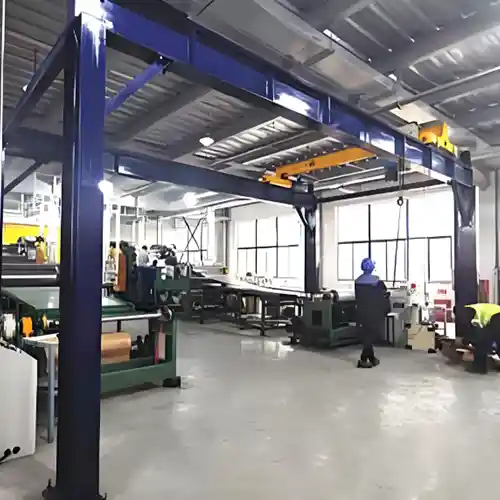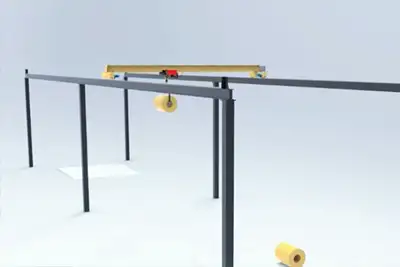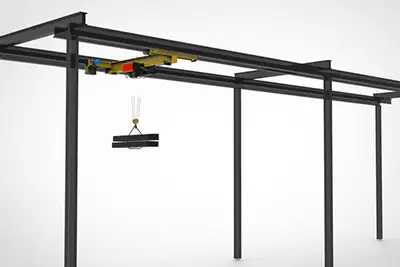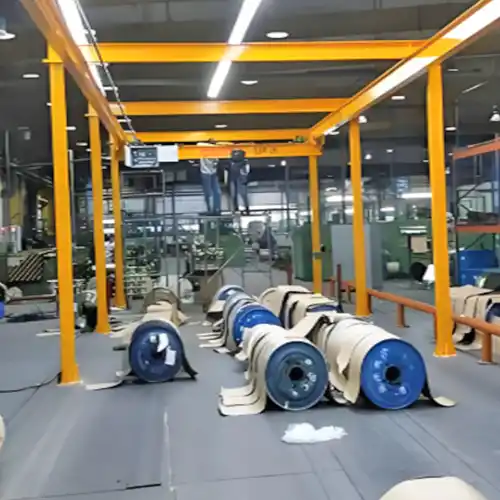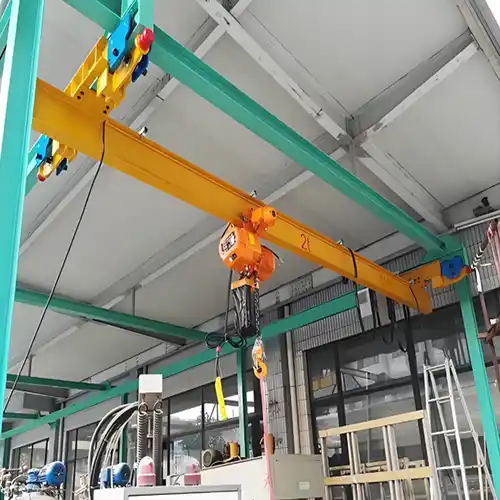Free Standing Bridge Cranes for Leased and Expanding Facilities
Free standing bridge cranes are ideal for leased workshops& expanding facilities. Easy to install, fully relocatable & customizable for growing operations.
Category: Featured
Your Trusted Freestanding Overhead Crane Manufacturer & Supplier
Free Standing Bridge Cranes for Sale
A Flexible Solution for Expanding or Leased Facilities
Many Workshops Face a Common Problem
If you’ve ever rented a workshop or leased an industrial unit, you know the challenge: you need an overhead crane, but the building isn’t yours. Modifying the structure might not be allowed, and even if it is, the cost and time can quickly add up. On top of that, businesses grow, layouts change, and what fits today might not work in a year.
Structural Limits and the Need for Flexibility
Leased spaces often have columns or low ceilings that make traditional overhead cranes difficult—or even impossible—to install. Some workshops have floor space constraints, others have ceilings that limit lifting height. And when expansion is on the horizon, installing a fixed crane tied to the building can create headaches down the line.
- Low ceiling height may reduce lifting height.
- Existing columns or beams may block crane installation.
- Modifying leased property could violate agreements.
- Future expansion might require a completely new crane system.
Why Free Standing Bridge Cranes Are a Practical Solution
This is where free standing bridge cranes come in. Unlike building-supported cranes, they stand on their own columns and don’t rely on the existing structure. That means no welding into someone else’s roof, no complicated civil work, and no headaches when it’s time to move.
- Can be installed in leased spaces without altering the building.
- Fully relocatable if you move or expand the workshop.
- Modular design allows length or span adjustments for future growth.
- Saves money on building reinforcement or restoration costs.
In short, free standing bridge cranes give you the flexibility to lift heavy loads safely while keeping your options open for the future. They are practical, reliable, and made to fit your space—not the other way around.
What Is a Free Standing Bridge Crane?
A free standing bridge crane is an overhead crane system that stands on its own, without depending on the building's structure for support. Unlike traditional cranes that are bolted to roof beams or columns, this type of crane has its own columns and runway system. That means it can be installed in almost any workshop, whether leased or low-ceilinged, and can even be moved if your business grows or relocates.
Key Components
To understand how these cranes work, it helps to break them down into their main parts:
- Freestanding Runway Columns: These vertical supports carry the weight of the crane and the load. They are designed to handle heavy lifting without relying on the workshop's roof or walls.
- Bridge Beam: The horizontal beam that spans across the columns. The hoist moves along this beam to lift and transport loads.
- End Trucks: These are mounted at both ends of the bridge beam and allow it to move along the runway. They carry the crane smoothly across the workshop floor.
- Electric or Manual Hoist: The hoist is what actually lifts the material. Depending on your needs, you can choose an electric hoist for frequent, heavy lifting, or a manual hoist for lighter, occasional work.
Common Configurations
Free standing bridge cranes are very adaptable, and manufacturers offer configurations to match different workshop needs:
- Single Girder or Double Girder: Single girder cranes are ideal for lighter loads and smaller spans. Double girder cranes can handle heavier weights and longer spans, making them suitable for industrial applications.
- Capacities from 1 Ton to 20 Tons: Most free standing cranes cover small to medium lifting needs, though custom designs can handle even higher capacities if required.
- Modular Design for Easy Installation and Relocation: Many systems are built in sections, so they can be installed quickly, adjusted to fit the space, or moved to another facility without major work.
A free standing bridge crane isn't just a lifting machine—it's a flexible solution that adapts to your space and business needs. You get the benefits of an overhead crane without the limitations of the building structure, which is especially valuable in leased or expanding workshops.
Why Leased and Expanding Facilities Prefer Free Standing Cranes
Free standing bridge cranes offer practical, flexible, and cost-efficient lifting solutions for leased or expanding facilities where building modifications are restricted or future reconfiguration may be needed.
No Building Modification Required
One of the biggest headaches in a leased workshop is getting approval to modify the building. Free standing bridge cranes solve this problem. They stand on their own columns, so there's no need to weld, bolt, or drill into the existing structure. That makes them fully compliant with property lease agreements, avoiding fines or lease violations.
- No welding into roof beams or walls.
- No drilling into columns or floors beyond foundation pads.
- Works even in rented spaces with strict modification restrictions.
With a free standing crane, you get a fully functional overhead lifting system without touching the building itself—practical, simple, and stress-free.
Easy Relocation and Reconfiguration
Workshops evolve, and so do your production needs. Free standing cranes are designed with flexibility in mind. They can be disassembled, moved, and reinstalled in a new location if your business expands or relocates. Modular runway systems make it easy to adjust the length or span without rebuilding the entire crane.
- Can be dismantled section by section for transport.
- Runway spans can be extended or shortened as needed.
- Reduces risk for businesses planning future moves or expansions.
This flexibility means you're not stuck with a crane that only fits your current facility. It's an investment that moves with your business.
Lower Total Cost of Ownership
Because free standing cranes don't require structural reinforcements, you save money on civil work, building modifications, and future restoration costs when leaving a leased property. The modular design also allows reuse in multiple facilities, extending the life and value of your investment.
- Avoid expensive foundation or building reinforcements.
- No restoration costs when vacating a leased workshop.
- Long service life; the crane can be reused for future projects or facilities.
In short, free standing bridge cranes combine practicality and cost efficiency. For leased or expanding facilities, they provide a lifting solution that is flexible, safe, and economical—exactly what growing businesses need.
freestanding overhead crane double girder design for heavy loads handing from 3 ton to 320 ton
freestanding overhead crane single girder design for heavy loads handing from 1 ton to 20 ton
Advantages Over Building-Supported Overhead Cranes
When it comes to installing overhead cranes, not all solutions are created equal. Building-supported cranes rely on the structure itself, which can be limiting in leased or expanding workshops. Free standing bridge cranes, on the other hand, offer practical benefits that make them the preferred choice for flexible operations.
Key Advantages
- No Building Modifications Needed: Free standing cranes have their own columns and runway, so you don’t have to touch the existing structure. Building-supported cranes often require drilling, welding, or reinforcing beams, which can be costly and may violate lease agreements.
- Faster Installation: Because there’s no need to wait for structural readiness, free standing cranes can be installed quickly. This reduces downtime and lets your workshop start lifting operations sooner.
- Portability: If you plan to relocate or expand, free standing cranes can be dismantled and moved to a new location. Building-supported cranes are fixed and non-transferable.
- Independent Maintenance Access: All components of a free standing crane are accessible without interfering with the building’s structure, making inspections and repairs easier.
Comparison Table
| Feature | Free Standing Bridge Crane | Building-Supported Crane |
|---|---|---|
| Building Modifications | Not required | Required (columns or beams) |
| Installation Time | Fast and simple | Depends on structure readiness |
| Portability | Fully relocatable | Fixed and non-transferable |
| Best For | Leased or expanding spaces | Permanent facilities |
| Maintenance | Independent access | Integrated with building |
Free standing bridge cranes give you control over your lifting operations without being constrained by the building. They are faster to install, easier to maintain, and can grow with your business—advantages that building-supported cranes simply cannot match.
Ideal Applications
Free standing bridge cranes are versatile and designed to fit a wide range of workshop scenarios. Their self-supporting structure and modular design make them perfect for facilities that need flexibility, quick installation, and adaptability.
Leased Industrial Units
For businesses operating in rented spaces, installing a traditional overhead crane can be tricky or even prohibited. Free standing bridge cranes solve this problem by standing independently, with no need to modify the building. They are ideal for short to mid-term production projects, allowing you to lift heavy materials without violating lease agreements.
- Perfect for temporary production lines.
- Works without structural modifications to the facility.
- Quick installation minimizes downtime in leased units.
Expanding Manufacturing Facilities
If your business is growing, chances are you'll add new bays, assembly lines, or workshop sections. Free standing cranes can adapt to these changes. Their modular runway systems allow length and span adjustments, so the crane can move with your expansion plans instead of being limited to one location.
- Runway spans can be extended or reconfigured.
- Can handle heavier loads in new production areas.
- Reduces the need to purchase multiple fixed cranes for future sections.
Rented Maintenance Workshops
Automotive, fabrication, and repair workshops often operate in rented spaces with limited structural options. Free standing bridge cranes provide the lifting capability you need while keeping the floor layout flexible. They make moving engines, heavy parts, or equipment safer and more efficient.
- Ideal for lifting engines, machinery, and large components.
- Easy to move within a workshop to optimize workflow.
- Suitable for workshops with low ceilings or floor restrictions.
Temporary or Contract-Based Projects
Some businesses work on short-term contracts, pilot projects, or seasonal production. In these cases, you need lifting equipment that is quick to set up, easy to remove, and fully reusable. Free standing bridge cranes fit the bill perfectly, allowing you to complete the job without long-term commitments to a building.
- Quick assembly and disassembly.
- Fully relocatable to other project sites.
- Reduces equipment downtime between contracts.
Design Flexibility and Customization
Free standing bridge cranes are built to fit the unique needs of each workshop. Unlike traditional cranes tied to the building structure, these cranes can be customized to make the most of your available space and operational requirements.
Low Headroom Options
In workshops with low ceilings, lifting height is often limited. Free standing cranes can be designed with shorter columns or low-profile girders to maximize usable height. This ensures that even in tight spaces, you can lift and move heavy loads safely.
- Custom column heights to match ceiling restrictions.
- Low-profile hoists that reduce hook approach distance.
- Ideal for workshops where every centimeter counts.
Span & Capacity Choices
Whether you need to lift a few tons or heavier industrial loads, free standing bridge cranes offer a wide range of options. Standard cranes typically cover spans up to 20 meters and capacities up to 20 tons, but manufacturers can create custom designs for specific requirements.
- Single girder or double girder options.
- Capacities from 1 ton to 20 tons, or higher on demand.
- Modular designs allow future expansion of the span or lifting capacity.
Foundation Solutions
The foundation must support the crane's weight and load safely. Free standing bridge cranes offer flexibility depending on floor conditions. Surface-mounted bases are common for concrete floors, while anchored designs provide extra stability when needed.
- Surface-mounted pads for standard concrete floors.
- Anchored bases for uneven or weaker floor conditions.
- Foundation designed to distribute load and avoid floor damage.
Hoist Compatibility
Free standing bridge cranes work with a variety of hoist types, making them versatile for different lifting tasks. You can choose wire rope or chain hoists, manual or electric, depending on your workflow and lifting frequency.
- Wire rope hoists for higher capacities and smoother lifting.
- Chain hoists for lighter loads and simple operations.
- Manual or electric options to match your production speed.
Key Considerations Before Buying
Choosing the right free standing bridge crane requires more than just picking a model off the catalog. Several practical factors can make a big difference in safety, efficiency, and long-term cost. Paying attention to these points ensures your crane fits your workshop today—and adapts to your needs tomorrow.
Floor Load-Bearing Capacity and Available Space
Before selecting a crane, it's crucial to evaluate the floor. The columns of a free standing crane transfer the load directly to the ground, so your floor must be able to support both the crane and the maximum lifted load. Additionally, measure your workshop layout carefully to ensure there's enough space for the crane's runway, the bridge beam, and safe movement of loads.
- Verify floor strength with a structural engineer if necessary.
- Check for obstacles like columns, machinery, or low-hanging fixtures.
- Plan for clearance around the crane for safe operation and maintenance.
Required Lifting Capacity and Frequency of Use
Different workshops have different lifting demands. Choose a crane with a capacity that exceeds your heaviest expected load. Also, consider how often the crane will be used—frequent lifts may require a more durable hoist and robust components to ensure longevity.
- Determine maximum load plus a safety margin (typically 20–30%).
- Consider daily usage to select between manual or electric hoists.
- Factor in uneven or flexible loads that may require slower, controlled lifting.
Future Relocation or Expansion Plans
One of the biggest advantages of free standing cranes is their flexibility. If you anticipate moving to a new workshop or expanding your current facility, choose a modular system that can be dismantled and reinstalled. Planning for future changes now saves money and headaches later.
- Opt for modular runways and bridge beams for easy relocation.
- Confirm the crane can be adjusted or extended if your production grows.
- Keep documentation for installation and disassembly procedures.
Power Supply, Control System, and Safety Accessories
Finally, check that your facility can support the crane's power requirements. Decide whether a pendant control, remote control, or both suits your workflow. Safety accessories such as limit switches, overload protection, and emergency stops are essential to protect operators and equipment.
- Verify voltage and electrical connection compatibility.
- Choose controls that match your operators' skills and workflow.
- Ensure all safety devices comply with local regulations and standards.
Benifits for You
Free standing bridge cranes aren’t just flexible in theory—they deliver real, measurable benefits in actual workshop settings. By looking at practical examples, you can see how these cranes save time, reduce costs, and adapt to changing business needs.
Case for References
- Leased Automotive Repair Shop
One automotive repair facility in a rented unit needed an overhead crane to handle engines and heavy components. Using a free standing bridge crane, the installation time was reduced by 60% compared to a building-supported system. No structural modifications were required, and the crane was up and running within days, allowing the workshop to continue operations without significant downtime. - Fabrication Plant Relocation
A medium-sized fabrication plant purchased a 5-ton free standing bridge crane for lifting steel beams and parts. When the plant expanded to a new facility, the crane was disassembled, moved, and reinstalled with minimal downtime. This avoided the cost of buying a completely new crane and eliminated the delays usually associated with building-supported systems.
Key Benefits Highlighted
- Time Savings: Quick installation and relocation reduce operational downtime.
- Cost Efficiency: Avoids structural reinforcement costs and new crane purchases.
- Adaptability: Can be reused in multiple facilities or adjusted for future expansion.
- Long-Term ROI: The initial investment pays off over multiple projects, locations, or expansions.
These real-world examples show why free standing bridge cranes are not just a lifting solution—they are a practical, long-term investment for businesses that need flexibility, reliability, and efficiency in workshops of any size.
Buyer and Engineer Tips
Selecting and installing a free standing bridge crane requires careful planning. The right choices now can save time, money, and frustration later. Here are some practical tips for buyers and engineers to consider:
Choose Modular Runway Designs for Scalability
A modular runway allows you to extend, shorten, or reconfigure the crane as your workshop evolves. This is especially useful for leased spaces or growing facilities where layouts may change.
- Sections can be added or removed without replacing the entire crane.
- Supports future expansion without major additional cost.
- Makes relocation or temporary setups much easier.
Work With Certified Manufacturers
Always choose suppliers that offer CE and ISO-certified crane systems. Certification ensures that the crane meets safety standards, quality requirements, and international compliance, giving peace of mind for daily operations.
- CE certification guarantees adherence to European safety standards.
- ISO certification ensures consistent quality and reliability.
- Certified systems reduce risk of operational downtime due to faults or non-compliance.
Ensure Proper Foundation Verification
Even though free standing cranes don't rely on building structure, their columns transfer loads to the floor. Verifying the foundation ensures safety and stability.
- Consult a structural engineer to check floor strength.
- Make adjustments if the floor cannot handle full crane and load weight.
- Choose surface-mounted or anchored bases depending on floor condition.
Keep Relocation Manuals and Layout Drawings
Free standing cranes are movable, but careful documentation simplifies future moves or reinstallation. Keep manuals and layout drawings organized for reference.
- Store installation and disassembly instructions safely.
- Maintain drawings of runway layout, column spacing, and power connections.
- Helps reduce errors and installation time when moving to a new facility.
Conclusion
Free standing bridge cranes provide a lifting solution that fits the needs of leased workshops and expanding facilities. Unlike building-supported cranes, they stand independently, require minimal installation work, and can be relocated or reconfigured as your business changes. Their modular design, customizable capacity, and compatibility with different hoist types make them a practical choice for almost any industrial setting.
- Flexible installation without modifying the building.
- Easy relocation or expansion as the workshop grows.
- Compatible with both manual and electric hoists for varying loads.
- Long-term cost savings through reusability and reduced downtime.
Instead of being restricted by ceiling height, columns, or structural limitations, a free standing bridge crane gives your workshop the freedom to operate efficiently and safely. Investing in one means you’re choosing a system that grows with your business, adapts to new challenges, and keeps your operations running smoothly for years to come.
Free standing bridge cranes are not just a piece of equipment—they’re a practical, future-ready solution for smart workshop management.
Related Products
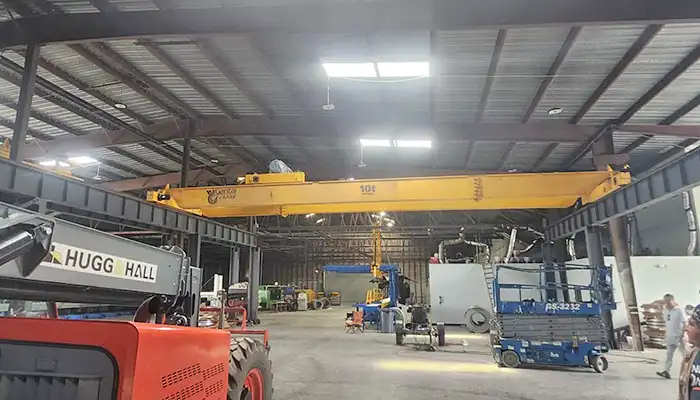
Affordable 10 ton double girder overhead crane with CD/MD hoist trolley, built for U.S. standards, ideal for construction and industrial lifting
Free consultation to Confirm Parameters & Specifications and Get
Latest Crane Price & Crane Rate.
- Types of overhead cranes : _______?
- Optional: Overhead travelling crane, goliath gantry crane,Slewing jib crane, Single girder or double girder crane,small portable crane or kbk crane, etc.
- Capacity of overhead crane: _______?
- Optional: 0.25ton, 0.5 ton, 1 ton, 2 ton, 3ton, 5 ton, 10 ton,15ton, 20ton, 25 ton, 30ton,35ton, up to 550ton, etc.
- Crane span & lifting height : _______?
- Crane travelling length : _____?
- Control of overhead crane:_______?
- Optional: pendant/ remote/cabin control
- Voltage supply of overhead crane:_____?
- Eg,: 380V50/60HZ,3Phase or others,etc.
- Application/usage of crane:_______?
- Eg,: Steel mill, ,injection mold, cement,stone, concrete,granite, general manufacturing, etc.
Just leave a message via the contact form and our hoist and crane engineer will contact you with in 24working hours.
Get In Touch
